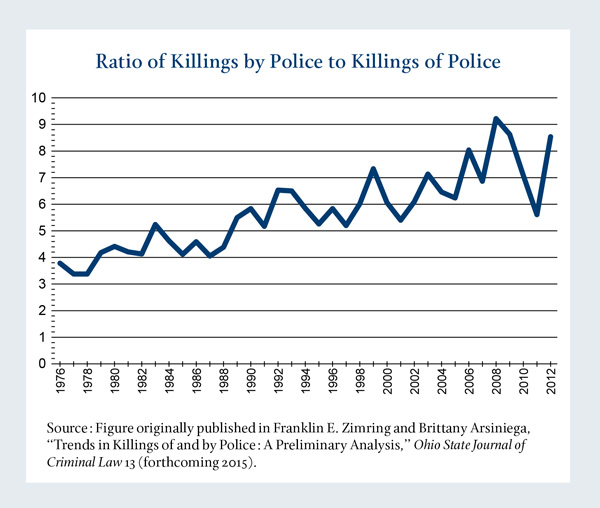On February 4, 2015, Andrea Roth (Assistant Professor of Law at the University of California, Berkeley School of Law) and Franklin Zimring (William G. Simon Professor of Law at the University of California, Berkeley School of Law) participated in a conversation at the University of California, Berkeley, on police use of lethal force against civilians. The program, which served as the Academy’s 2016th Stated Meeting, included a welcome from Nicholas B. Dirks (Chancellor of the University of California, Berkeley). During the event, Jonathan F. Fanton (President of the American Academy) recognized distinguished Academy Fellow Jesse H. Choper (Earl Warren Professor of Public Law and former Dean at the University of California, Berkeley School of Law) for his many years of service to the Academy. The following is an edited transcript of the discussion.

I am going to speak about what we do and do not know about police use of lethal force in the United States: how often it happens, how the practice has changed over time, and the circumstances under which it occurs. My colleague Franklin Zimring will follow by talking about what we can and should do about it.
Here is what we know: between four hundred and five hundred people in the United States are killed each year by police officers acting in the line of duty. That is about ten times the number of people who are executed each year in the United States. We also know, however, that this figure has been stable over time. In public health parlance, we might call homicides by police a chronic problem, rather than an epidemic.
Nonetheless, the annual number of killings by police is a dark figure that has had a low-visibility career, owing largely to a system of fragmented political accountability for police killings. The United States has seventeen thousand police departments – mostly municipal and county agencies – which, amazingly, are not required by state and federal agencies to keep data on police use of lethal force. The FBI’s Uniform Crime Reports and the supplemental homicide reports from the National Archive of Criminal Justice Data do list justifiable homicides by police officers that are reported by U.S. police departments each year. But these numbers are indisputably incomplete: they are unaudited, they are self-reported, and they include only justifiable homicides.
To give you a sense of the incompleteness, a Wall Street Journal investigation in December of 2014 looked at the internal records of the largest one hundred and five police departments in the country. The report found five hundred and fifty homicides by police officers between 2007 and 2012 that were not accounted for in the Uniform Crime Reports.
Available data on police killings are not only numerically incomplete, but also do not distinguish the circumstances of the killings. Because the killings are justified (and, to be clear, nearly all killings by police officers are characterized by federal officials as justifiable), they do not merit the type of data collection by the FBI that crimes such as killings of police have always merited. Thus, the circumstances of justified killings are hard to discern. It used to be that an officer could shoot a fleeing felon and not be deemed to have used excessive force. But this doctrine was struck down by the Supreme Court’s 1985 decision in Tennessee v. Garner, which stated that lethal force by police is only justified under the Fourth Amendment’s prohibition against unreasonable searches and seizures if, based on an imminent and deadly threat, the officer had reasonable fear for his or others’ safety. Garner represented a moral victory, but in practice, for obvious reasons, the criteria justifying lethal force in a shooting are difficult to scrutinize after-the-fact.
That said, we can use existing data, however questionable and incomplete it is, to analyze trends in the ratio of killings of police to killings by police over time and gain a sense of the relationship between killings by police and actual threats to officer safety. The results are striking. Killings of police have dropped by 69 percent over the past thirty-five years. Part of that decline is due to the period’s overall decrease in homicide risk, and part is due to technological advances that have reduced police vulnerability, such as the Kevlar vest. But whatever the reasons, urban policing is a much less dangerous job in 2015 than it was in 1975. At the same time, there has only been a 31 percent drop in killings by police. If we express these numbers as a “kill ratio,” if you will – meaning the ratio of killings by police to killings of police – we see that the ratio has always been high, greater than three to one. But that ratio has more than doubled since 1977 (see Figure 1).
| Figure 1 |
 |
We also know which weapons do and do not mortally threaten police. We are clearly in an era of proliferation of guns in public spaces. And those guns pose serious risks to officers, especially in domestic violence interventions and traffic stops. But officers do not seem to be at a high risk of death in assaults that involve a weapon other than a firearm. Among the 265 officers killed from 2008 to 2012, for example, only two were killed by a knife; 91 percent were killed by a firearm.
Now those numbers might simply mean that suspects just are not wielding knives against police officers. But if you look at the weapons used in criminal homicides overall, a full 13 percent involved a knife. Meanwhile, 20 percent of conventional aggravated assaults featured a knife. And although the FBI does not share data on weapons used by suspects in killings of police, another database does. The Wikipedia open-source database has collected press records relating to police killings since 2009. According to the records, of the 352 cases from 2012 that involved suspects whom the officers reported as wielding a knife, a gun, or what the officer reported as a possible gun or knife, nearly 20 percent involved knives exclusively.
So even with our incomplete and unaudited data, it seems fair to say that a not-insubstantial proportion of police use of lethal force – at least in those cases not involving firearms – is unnecessary as a means of ensuring police safety.
Finally, let me talk about race. It is clear that black men are killed by police in numbers disproportionate to their share of the population. Thirty-eight percent of suspects killed by on-duty police are African American, while African Americans make up only 13 percent of the U.S. population. It is difficult to make quantitative claims about how much of this disparity is due to implicit or explicit racial bias; we do not know what the baseline for comparison should be. We cannot simply look to crime statistics, since police killings of civilians do not only happen during crimes-in-progress or attempted arrests. And we do not have data on the racial breakdown of suspects involved in police-citizen encounters in which a suspect is killed after posing no reasonably apparent risk of wielding a firearm against the officer. Even if such data existed, it might be affected by implicit bias. But we do have studies that show, for example, that undergraduates acting as police in computer simulations are more likely to shoot African American suspects than white suspects under identical conditions, in terms of both suspect behavior and weapon status.
Obviously, the inspiration for this discussion today was the killings of Michael Brown in Ferguson and Eric Garner in Staten Island. But as I said at the outset, this is a chronic problem and an old problem. What Ferguson and Staten Island did, because of the unusual visibility of these events and their effect on a population that previously did not have the political capital to ask for this data, was to finally render visible a problem that had been in the dark, waiting to be better understood.

I would like to address one very easy question, and one very difficult question. Let’s begin with the easy question: is five hundred killings a year by police officers – the vast majority of which are local police – too many? The answer is yes. By how many is it too many? Well, that depends on what kind of standard of comparison you want to use. Were you to compare the United States with other developed countries, the conclusion would be astonishing. The number of citizens of the United Kingdom killed by police in a year could be counted on the fingers of one hand. Now, their population is about one-fifth of the United States, yet their police killings rate is vastly lower than the United States’. Adjusted for population, the rate of civilian killings by police in the United States is fifty times the rate of fatal shootings by police in England and Wales. German police kill one citizen per ten million each year; our death rate is sixteen times higher. Is it feasible to reduce the number of killings by American police to match the rates of our Western European counterparts? No, it is not.
But given the communities our police patrol and the pervasive culture of handgun ownership in the United States, what number of police killings of civilians would be “appropriate” in 2015? Concealed handguns threaten the lives of municipal police and that is what provokes lethal force from them. A good policy target would be to reduce police killings by one-half, from about five hundred to two hundred and fifty killings a year. Now, those two hundred and fifty instances of lethal force would still overwhelmingly target the poor and those with dark skin. And two hundred and fifty killings is a huge cost in lives and human dignity. But the policies that could produce a reduction to two hundred and fifty deaths a year are very much worth finding.
In what situations could a change in policing tactics lead to reductions in civilian casualties? As Andrea mentioned, about one hundred civilians are killed per year in the United States by police who believe that they are being assaulted with knives, blunt instruments, or personal force – all of which do not typically put the police officers’ lives at risk. Thus, the situation calls for a less-than-lethal response from police. Further, when police officers do begin shooting, for justified or unjustified reasons, the majority will keep shooting for longer than is necessary to extinguish the threat. It isn’t a question of firing one, two, or three rounds. Because most of these shootings are not the result of officers acting alone, but rather of officers working in pairs, police not infrequently shoot multiple rounds at a single target – to “make sure.” Of course, the desire to make sure that the suspect is dead or incapacitated elevates the death rate in shooting incidents substantially.
Finally, police officers frequently press forward in situations where they simply do not have to take action. Imagine that police observe two people sitting in a car at two thirty in the morning, and – suspecting that a crime is in progress – the officers approach the vehicle with their guns drawn. No crime has been reported. The officers are advancing solely based on their observations and instincts. Approaching the suspected criminals in this manner easily leads to situations in which surprised and alarmed civilians might make gestures that police will interpret as an attempt to be “going for a gun.”
So, there are three circumstances in which we could work to decrease the death toll from police lethality: police responding to nonlethal threats with lethal force; police shooting more than is necessary to ensure death; and police engaging potential threats when not required. But now for the very difficult question: how are we going to do it? Let’s first look at one proposed mechanism, the use of criminal law to charge and convict police officers who commit unlawful homicide. In the United States we require proof beyond a reasonable doubt to justify a criminal conviction. And that is proof of the absence of a subjective element – for example, did the police officer, in fact, believe his life was at risk or that a gun was being drawn? And if you can’t prove the officer did not perceive a genuine risk, you cannot convict him. Further, prosecutors and juries tend to think like police officers; they want to believe police officers. So only shootings in which the police obviously were not in peril or egregiously used excessive force are going to lead to criminal convictions of the offending officers. The cases of Oscar Grant – who was shot by a BART (Oakland public transportation) police officer while lying face-down on the ground – and Rodney King – who was beaten excessively by LAPD following a car chase – illustrate this rule. Pursuing criminal charges against officers is simply not effective enough to save significant numbers of civilian lives.
Then what will? To begin: federal lawsuits for damages. Being forced to pay damages is a powerful deterrent, and is at least ten times more likely to happen than the criminal conviction of an officer. Moreover, settlements paid by cities should be directly linked to repercussions for their police department; in current practice, city governments accept the burden of paying damages, leaving police budgets unscathed. So money talks, and money can save lives. But even more important is motivating police administrators to create both incentives for using nonlethal force and disincentives for using lethal force. If restraint is rewarded and excess is punished within police departments, the civilian death toll can really drop. Further, reducing discretionary confrontations between police and civilians to begin with will also only make the streets safer.
But how do you gain the support of police administrators for this cause? What leverage do we have? Section 14141 of the Federal Crime Control Act of 1994 gives the Department of Justice the power to review local police departments who may be systemically violating citizens’ federally protected rights, and to intervene in civil actions with consent decrees. The Department of Justice’s recent findings on the pervasive racism in the Ferguson, Missouri, police department is one such review; and it has also intervened in Los Angeles, Oakland, and Albuquerque. So the path from five hundred police killings of civilians per year to two hundred and fifty is much more a path of administrative reform and fiscal engineering than a dependence on or reform of criminal law.
Two hundred and fifty killings a year would still be cause for concern; but compared with the death toll of 2015, it would be significant progress in an area that has long been ignored.
© 2015 by Andrea Roth and Franklin Zimring, respectively
To view or listen to the presentations, visit https://www.amacad.org/lethalforce.